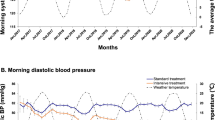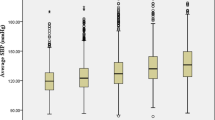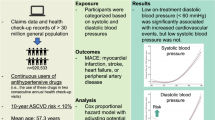Abstract
The American College of Cardiology and the American Heart Association (ACC/AHA) 2017 guidelines for hypertension management lowered blood pressure (BP) thresholds to 130/80 mmHg to define hypertension while the European Society of Cardiology and the European Society of Hypertension (ESC/ESH) 2018 guidelines retained 140/90 mmHg. Both guidelines recommend adapting management for older patients with complex health conditions, without however clear indications on how to adapt. Our aims were to assess the impact of lowering BP thresholds on the prevalence of elevated BP and BP control, as well as the proportion of participants with a complex health condition across these BP categories. We used data from 3210 participants in the Lausanne cohort Lc65+ aged between 67 and 80 years. Hypertension diagnosis and antihypertensive medication use were self-reported. BP was measured three times at one visit. Some 51% of participants reported having hypertension and 44% reported taking antihypertensive medication. Compared with ESC/ESH thresholds, the prevalence of measured elevated BP was 24% percentage points higher and BP control was 24% percentage points lower using ACC/AHA thresholds. About one out of two participants with elevated BP and four out of five participants with uncontrolled BP had a complex health condition, i.e., frailty, multimorbidity, or polypharmacy. To comply with ACC/AHA guidelines, considerable effort would be required to reach BP control. This is a serious challenge because a large share of hypertensive older adults has complex health conditions, a type of patients for whom there is no strong evidence on how to manage hypertension.
This is a preview of subscription content, access via your institution
Access options
Subscribe to this journal
Receive 12 digital issues and online access to articles
$119.00 per year
only $9.92 per issue
Buy this article
- Purchase on Springer Link
- Instant access to full article PDF
Prices may be subject to local taxes which are calculated during checkout


Similar content being viewed by others
References
Whelton PK, Carey RM, Aronow WS, Casey DE Jr, Collins KJ, Dennison Himmelfarb C, et al. 2017 ACC/AHA/AAPA/ABC/ACPM/AGS/APhA/ASH/ASPC/NMA/PCNA Guideline for the prevention, detection, evaluation, and management of high blood pressure in adults: executive summary: a report of the American College of Cardiology/American Heart Association Task Force on Clinical Practice Guidelines. Hypertension. 2018;71:1269–324.
Williams B, Mancia G, Spiering W, Agabiti Rosei E, Azizi M, Burnier M, et al. 2018 ESC/ESH Guidelines for the management of arterial hypertension. Eur Heart J. 2018;39:3021–104.
Anker D, Santos-Eggimann B, Santschi V, Del Giovane C, Wolfson C, Streit S, et al. Screening and treatment of hypertension in older adults: less is more? Public Health Rev. 2018;39:26.
Karmali KN, Lloyd-Jones DM, van der Leeuw J, Goff DC Jr., Yusuf S, Zanchetti A, et al. Blood pressure-lowering treatment strategies based on cardiovascular risk versus blood pressure: a meta-analysis of individual participant data. PLoS Med. 2018;15:e1002538.
Khera R, Lu Y, Lu J, Saxena A, Nasir K, Jiang L, et al. Impact of 2017 ACC/AHA guidelines on prevalence of hypertension and eligibility for antihypertensive treatment in United States and China: nationally representative cross sectional study. BMJ. 2018;362:k2357.
Gijon-Conde T, Sanchez-Martinez M, Graciani A, Cruz JJ, Lopez-Garcia E, Ortola R, et al. Impact of the European and American guidelines on hypertension prevalence, treatment, and cardiometabolic goals. J Hypertens. 2019;37:1393–400.
Wilt TJ, Kansagara D, Qaseem A.Clinical Guidelines Committee of the American College of Physicians Hypertension limbo: balancing benefits, harms, and patient preferences before we lower the bar on blood pressure. Ann Intern Med. 2018;168:369–70.
Lewington S, Clarke R, Qizilbash N, Peto R, Collins R, Prospective Studies Collaboration. Age-specific relevance of usual blood pressure to vascular mortality: a meta-analysis of individual data for one million adults in 61 prospective studies. Lancet. 2002;360:1903–13.
Williamson JD, Supiano MA, Applegate WB, Berlowitz DR, Campbell RC, Chertow GM, et al. Intensive vs standard blood pressure control and cardiovascular disease outcomes in adults aged ≥75 years: a randomized clinical trial. JAMA. 2016;315:2673–82.
Husten L. Search results for: SPRINT. 2017. In: CardioBrief. http://www.cardiobrief.org/?s=SPRINT.
Richmond R, Law J, Kay-Lambkin F. Higher blood pressure associated with higher cognition and functionality among centenarians in Australia. Am J Hypertens. 2011;24:299–303.
Sabayan B, Oleksik AM, Maier AB, van Buchem MA, Poortvliet RK, de Ruijter W, et al. High blood pressure and resilience to physical and cognitive decline in the oldest old: the Leiden 85-plus study. J Am Geriatr Soc. 2012;60:2014–9.
Benetos A, Petrovic M, Strandberg T. Hypertension management in older and frail older patients. Circ Res. 2019;124:1045–60.
Santos-Eggimann B, Karmaniola A, Seematter-Bagnoud L, Spagnoli J, Bula C, Cornuz J, et al. The Lausanne cohort Lc65+: a population-based prospective study of the manifestations, determinants and outcomes of frailty. BMC Geriatr. 2008;8:20.
Ville de Lausanne. Contrôle des habitants. http://www.lausanne.ch/lausanne-officielle/administration/securite-et-economie/controle-des-habitants.html. Accessed 28 June 2019.
The Lc65+ cohort. Sampling. https://lc65plus.iumsp.ch/en/content/sampling. Accessed 8 April 2019.
Anker D, Santos-Eggimann B, Zwahlen M, Santschi V, Rodondi N, Wolfson C, et al. Blood pressure in relation to frailty in older adults: a population-based study. J Clin Hypertens. 2019;21:1895–1904.
El Assaad MA, Topouchian JA, Darne BM, Asmar RG. Validation of the Omron HEM-907 device for blood pressure measurement. Blood Press Monit. 2002;7:237–41.
White WB, Anwar YA. Evaluation of the overall efficacy of the Omron office digital blood pressure HEM-907 monitor in adults. Blood Press Monit. 2001;6:107–10.
Fried LP, Tangen CM, Walston J, Newman AB, Hirsch C, Gottdiener J, et al. Frailty in older adults: evidence for a phenotype. J Gerontol A Biol Sci Med Sci. 2001;56:M146–56.
Johnston MC, Crilly M, Black C, Prescott GJ, Mercer SW. Defining and measuring multimorbidity: a systematic review of systematic reviews. Eur J Public Health. 2019;29:182–9.
Benetos A, Rossignol P, Cherubini A, Joly L, Grodzicki T, Rajkumar C, et al. Polypharmacy in the aging patient: management of hypertension in octogenarians. JAMA. 2015;314:170–80.
Danon-Hersch N, Marques-Vidal P, Bovet P, Chiolero A, Paccaud F, Pecoud A, et al. Prevalence, awareness, treatment and control of high blood pressure in a Swiss city general population: the CoLaus study. Eur J Cardiovasc Prev Rehabilit. 2009;16:66–72.
Brindel P, Hanon O, Dartigues JF, Ritchie K, Lacombe JM, Ducimetiere P, et al. Prevalence, awareness, treatment, and control of hypertension in the elderly: the Three City study. J Hypertens. 2006;24:51–8.
Gordis L. Epidemiology. 5th ed. Philadelphia, PA: Elsevier Saunders; 2013. p. 416.
Brummett BH, Babyak MA, Siegler IC, Shanahan M, Harris KM, Elder GH, et al. Systolic blood pressure, socioeconomic status, and biobehavioral risk factors in a nationally representative US young adult sample. Hypertension. 2011;58:161–6.
Marmot M, Bell R. Fair society, healthy lives. Public Health. 2012;126:S4–10.
Moore MN, Atkins ER, Salam A, Callisaya ML, Hare JL, Marwick TH, et al. Regression to the mean of repeated ambulatory blood pressure monitoring in five studies. J Hypertens. 2019;37:24–9.
Chiolero A, Anker D. Screening interval: a public health blind spot. Lancet Public Health. 2019;4:e171–2.
Bress AP, Muntner P, Moran AE. Response by Bress et al. to Letters Regarding Article, “Potential Cardiovascular Disease Events Prevented With Adoption of the 2017 American College of Cardiology/American Heart Association Blood Pressure Guideline”. Circulation. 2019;139:e1023–4.
Olsen MH, Angell SY, Asma S, Boutouyrie P, Burger D, Chirinos JA, et al. A call to action and a lifecourse strategy to address the global burden of raised blood pressure on current and future generations: the Lancet Commission on hypertension. Lancet. 2016;388:2665–712.
Moynihan RN, Clark J, Albarqouni L. Media Coverage of the benefits and harms of the 2017 expanded definition of high blood pressure. JAMA Intern Med. 2019;179:272–3.
Bell KJL, Doust J, Glasziou P. Incremental benefits and harms of the 2017 American College of Cardiology/American Heart Association High Blood Pressure Guideline. JAMA Intern Med. 2018;178:755–7.
Flack JM, Calhoun D, Schiffrin EL. The new ACC/AHA hypertension guidelines for the prevention, detection, evaluation, and management of high blood pressure in adults. Am J Hypertens. 2018;31:133–5.
Messerli FH, Bangalore S. The blood pressure landscape: schism among guidelines, confusion among physicians, and anxiety among patients. J Am Coll Cardiol. 2018;72:1313–6.
Funding
The Lc65+ study has been supported by University of Lausanne Hospital Centre; University of Lausanne Department of Ambulatory Care and Community Medicine; Canton de Vaud Department of Public Health; City of Lausanne; Loterie Romande [research grants 2006–2008 and 2018–2019]; Lausanne University Faculty of Biology and Medicine [multidisciplinary research grant 2006]; Swiss National Foundation for Scientific Research [grant 3247B0-120795/1]; and Fondation Médecine Sociale et Préventive, Lausanne. The sponsors had no role in the design, execution, analysis and interpretation of data, or writing of the study.
Author information
Authors and Affiliations
Corresponding author
Ethics declarations
Conflict of interest
The authors declare that they have no conflict of interest.
Additional information
Publisher’s note Springer Nature remains neutral with regard to jurisdictional claims in published maps and institutional affiliations.
Supplementary information
Rights and permissions
About this article
Cite this article
Anker, D., Santos-Eggimann, B., Zwahlen, M. et al. Blood pressure control and complex health conditions in older adults: impact of recent hypertension management guidelines. J Hum Hypertens 35, 280–289 (2021). https://doi.org/10.1038/s41371-020-0334-4
Received:
Revised:
Accepted:
Published:
Issue Date:
DOI: https://doi.org/10.1038/s41371-020-0334-4
This article is cited by
-
Slow on the Draw—ED Management of Elevated BP in Older Adults
Current Hypertension Reports (2024)



